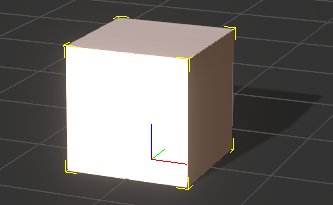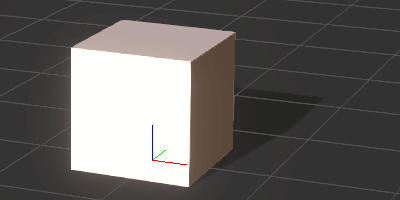Difference between revisions of "IC Python API:Transformation Key"
Chuck (RL) (Talk | contribs) m (→winreg) |
Chuck (RL) (Talk | contribs) m |
||
| Line 2: | Line 2: | ||
{{Parent|IC_Python_API:RL_Python_Samples|RL Python Samples}} | {{Parent|IC_Python_API:RL_Python_Samples|RL Python Samples}} | ||
| − | This article focuses on animating a prop by keying its transformation | + | This article focuses on animating a prop by keying its transformation as more powerful alternative method. |
| + | |||
| + | === Animating the Basic Way === | ||
| + | |||
| + | The usual method of animating objects is by setting component data on transform data-block like below: | ||
<syntaxhighlight lang="Python"> | <syntaxhighlight lang="Python"> | ||
| Line 11: | Line 15: | ||
</syntaxhighlight> | </syntaxhighlight> | ||
| − | If you are setting multiple values with position, rotation, and scale then the lines of code can become quite hefty. You may be better off with setting a transform matrix for the object to adopt and make the entire code more manageable. | + | === Animating the Powerful Way === |
| + | |||
| + | If you are setting multiple values with position, rotation, and scale then the lines of code can become quite hefty. You may be better off with setting a transform matrix for the object to adopt, and therefore, make the entire code more manageable. | ||
== Necessary Modules == | == Necessary Modules == | ||
Revision as of 01:50, 24 April 2019
- Main article: RL Python Samples.
This article focuses on animating a prop by keying its transformation as more powerful alternative method.
Animating the Basic Way
The usual method of animating objects is by setting component data on transform data-block like below:
data_block = prop.GetControl("Transform").GetDataBlock()
data_block.SetData("Position/PositionX", RLPy.RTime(0), RLPy.RVariant(100))
data_block.SetData("Position/PositionY", RLPy.RTime(0), RLPy.RVariant(0))
data_block.SetData("Position/PositionZ", RLPy.RTime(0), RLPy.RVariant(50))
Animating the Powerful Way
If you are setting multiple values with position, rotation, and scale then the lines of code can become quite hefty. You may be better off with setting a transform matrix for the object to adopt, and therefore, make the entire code more manageable.
Necessary Modules
Besides the RLPy standard module, we'll need two system based modules to load a prop from a directory with the likes of os and winreg
import RLPy
import os
import winreg
os
The os module provides a portable way of using operating system dependent functionality. For more information, see os.html
winreg
winreg offers functions that exposes the Windows registry API to Python. For more information, see winreg.html
Loading a Test Prop
Let's start by loading in a box object for the purpose of animation.
# Get the iClone 7 default template path
registry = winreg.ConnectRegistry(None, winreg.HKEY_LOCAL_MACHINE)
rawKey = winreg.OpenKey(registry, r"SOFTWARE\Reallusion\iClone\7.0")
ic_template_path = os.path.abspath(
winreg.QueryValueEx(rawKey, "Template Data")[0])
# Load Box_001.iProp
RLPy.RFileIO.LoadFile(
ic_template_path + "//iClone Template//Props//3D Blocks//Box_001.iProp")
This gives us the following result:
Creating a Transformation Matrix
Next, we'll need to create a transform object and fill it with scale, rotation, and translation information. The transform object is simply a 3x3 matrix where each transformational component occupies a row.
# Create a quaternion from euler angles
m3 = RLPy.RMatrix3().FromEulerAngle(RLPy.EEulerOrder_XYZ, 0,
45 * RLPy.RMath.CONST_DEG_TO_RAD, 0)[0]
q_rotation = RLPy.RQuaternion().FromRotationMatrix(m3)
# Create a transform matrix
xform = RLPy.RTransform(
RLPy.RVector3(0.25, 0.25, 0.25), # Scale
q_rotation, # Rotation
RLPy.RVector3(100, 0, 100) # Translation
)
Notice that the second row of the transform matrix is occupied with a quaternion rotation. In order to input euler values, which is easier to understand by the layman, we must convert the eular angles to a rotational 3x3 matrix and convert that to a quaternion rotation.
Animating the Box
Finally we'll need to set a key to the transform controller to animate the box.
# Get the imported box
prop = RLPy.RScene.FindObject(RLPy.EObjectType_Prop, "Box_001")
# Set the transform matrix values for the 3 second mark
prop.GetControl("Transform").SetValue(RLPy.RTime(3000), xform)
# Playback the scene for test
RLPy.RGlobal.Play(RLPy.RTime(0), RLPy.RTime(3000))
This gives us the following result:
Everything Put Together
You can copy and paste the following code into a PY file and load it into iClone via Script > Load Python.
import RLPy
import os
import winreg
# Get the iClone 7 default template path
registry = winreg.ConnectRegistry(None, winreg.HKEY_LOCAL_MACHINE)
rawKey = winreg.OpenKey(registry, r"SOFTWARE\Reallusion\iClone\7.0")
ic_template_path = os.path.abspath(
winreg.QueryValueEx(rawKey, "Template Data")[0])
# Load Box_001.iProp
RLPy.RFileIO.LoadFile(
ic_template_path + "//iClone Template//Props//3D Blocks//Box_001.iProp")
# Create a quaternion from euler angles
m3 = RLPy.RMatrix3().FromEulerAngle(RLPy.EEulerOrder_XYZ, 0,
45 * RLPy.RMath.CONST_DEG_TO_RAD, 0)[0]
q_rotation = RLPy.RQuaternion().FromRotationMatrix(m3)
# Create a transform matrix
xform = RLPy.RTransform(
RLPy.RVector3(0.25, 0.25, 0.25), # Scale
q_rotation, # Rotation
RLPy.RVector3(100, 0, 100) # Translation
)
# Get the imported box
prop = RLPy.RScene.FindObject(RLPy.EObjectType_Prop, "Box_001")
# Set the transform matrix values for the 3 second mark
prop.GetControl("Transform").SetValue(RLPy.RTime(3000), xform)
# Playback the scene for test
RLPy.RGlobal.Play(RLPy.RTime(0), RLPy.RTime(3000))
APIs Used
You can research the following references for the APIs deployed in this code.



